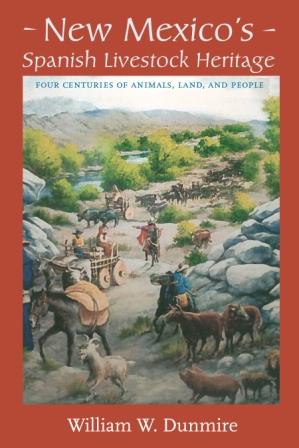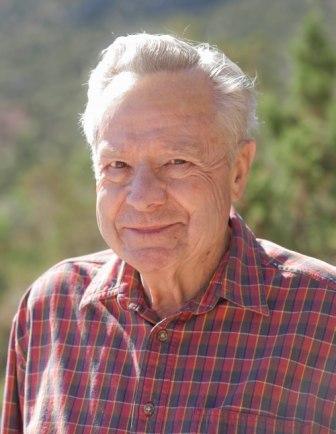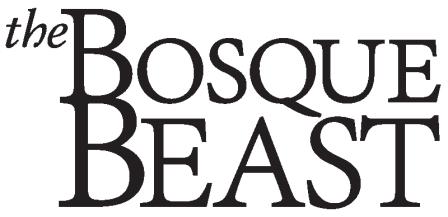Past herding practices continue to shape New Mexico in the present
So many debates about animal control in New Mexico trace their roots to the history of livestock ranching that it’s no longer possible to consider the wild without the domestic. From the free-roaming horses in Placitas to unwanted coyotes to feral pigs down south, it’s humans who first unleashed these animals on the landscape—which in this case means the Spanish conquistadors.

That makes William Dunmire’s new account of ranching in New Mexico an unexpected find for animal-lovers in the history section. Subtitled “Four Centuries of Animals, Land, and People,” New Mexico’s Spanish Livestock Heritage (UNM Press, 2013) takes a thoroughly modern approach to history, looking not only at human exploits and practices, but also at how the particularities of chicken, sheep, cattle, goats, and pigs themselves helped steer the course of human events.

A wildlife biologist and mountaineer who spent three decades with the National Park Service, Dunmire wrote several books on New Mexico plant history before turning his attention back to animals. Now in his early 80s, the Placitas resident has accomplished more in retirement than many people do in their entire careers. Since his book was released, he has presented the material at dozens of venues. We sat down with him recently to discuss his findings.
The story begins with Columbus, who introduced to North America in 1492 nearly all the animals that we call livestock today. Horses, mules, donkeys, cattle, sheep, goats, and pigs traveled with the explorers as their living food source. Spanish livestock, in other words, is American livestock.
Likewise, many of the practices and equipment we associate with Western ranching come directly from Spain, including the lasso, the Western saddle, cattle branding, and ear cropping.
The explorers who first set foot in the Americas found highly organized societies that astonishingly lacked any beasts of burden except the llama. They had no wheel. The only domestic animals were dogs, turkeys, llamas, alpacas, guinea pigs, and ducks.
“Domestic livestock was a basic reason why so-called civilization exists,” Dunmire explains. “In the Old World, the work was being done by animals; in the Americas, the work was being done by people. In Chaco, those five-story structures with logs weighing hundreds of pounds were being carried on people’s backs, because there was no working wheel. This is without a doubt the big difference in how Asia and Europe progressed.”
Beasts of burden quickly and permanently transformed the New World and its people, especially the Native tribes. Dunmire believes New Mexico’s history offers the most interesting window into this process, because the story begins so early and includes all the main ethnic groups. “New Mexico’s economy was dependent on livestock for three and a half to four centuries,” he notes.
Juan de Oñate’s massive 1598 expedition from present-day Mexico brought to North America 1,300 horses, 300 oxen, 100 donkeys and mules, 1,600 cattle, 3,400 sheep, 1,000 goats, and 60 pigs. Of these, sheep were the most highly prized by both the Spanish (who were mostly sheep farmers) and the Pueblo Indians, who hated how cattle would trample their fields.
By chance, the lowly Churro sheep that were sent on New World expeditions—the prized Merino sheep being too valuable—turned out to thrive on arid terrain. And Churro wool turned out to be quite similar in texture and handling to the cotton that Native tribes had been weaving and dyeing for millennia, which led them to adopt it very quickly as their textile of choice.
Mutton also happened to be the meat preferred by both whites and Indians. As a result, over the next two centuries, the sheep population of New Mexico exploded, becoming the territory’s primary currency in trading with the entire West. By the late 1800s, New Mexico counted some 5 million head, overrunning mountain meadows to mesa to river valleys.
These oceans of sheep, with their trampling hooves and habit of eating down to the base of plants, permanently damaged the plains landscape. The fertile grasslands of the Rio Grande Valley became the dry scrub that we know today. Amazingly, visitors in previous centuries had described luxuriant plains of native grass, even in the Jornado del Muerto.
“Sheep converted the grasslands, from our perspective, permanently,” says Dunmire. “Now the Rio Puerco is just a ditch—that’s what the sheep did.”
The impact reached its peak in the late 1800s, as shrubs like juniper, sage, broom snakeweed, and cholla cactus overtook the grass; in the south it was creosote and mesquite. The damage wasn’t officially recognized until 1908, when a report documented the damage caused by soil erosion and runoff.
Today it is known that sheep browsing young cottonwood and willow trees in the bosque helped invasive species like salt cedar and Russian olive take root. In the mountains, sheep grazed meadows clean of native flora, which has never come back. In the forests, grazing eliminated the ground-level vegetation that used to spark low-intensity fires, fueling instead the massive, destructive fires of today.
Cattle were always herded in New Mexico, more intensively by the Anglos in long drives after 1860. But their impact was far less damaging because they were grazed primarily on the eastern plains, where they happened to fill an ecological niche left by massive slaughter of the American Bison. Today, cattle are, of course, the main livestock story in New Mexico, nearly all of it for milk. Dairy products are the state’s top agricultural activity, more economically significant than pecans or chilies. Sheep, meanwhile, are down to 110,000 head, mostly on Navajo lands.
An ongoing dispute over the free-roaming horses of Placitas offers a good example of the lingering impacts of Old World, free-for-all livestock management. Allegedly abandoned by San Felipe Pueblo, the horses have multiplied to the point of plaguing Dunmire’s own community, where horse-lovers and ecologists clash over the dangers they pose. As an ecologist, Dunmire sides with those who consider the horses feral, and damaging to the landscape.
“If they were wild, they would have a natural predator,” he says, calling it a very recent phenomenon. In biological surveys of Placitas Open Space that he conducted for Las Placitas Association in 1997 and 2007, no horses were found, though residents began reporting them six or seven years ago.
“Now there are so many, they’re destroying the landscape and people’s homes, threatening water sources,” Dunmire says. “More and more people are getting upset.” He shows photos at his presentations of the land on each side of a fence, documenting the damage caused by horse grazing. “It’s like the five million sheep,” he says.
The impact of livestock on the Native American tribes is a mixed story, contributing for many years to economic improvement, but also setting them on the modern path of losing touch with wild nature. It was the Franciscan missionaries who taught the Pueblo people to ride horses, tend sheep, and breed their own flocks. For the Plains tribes, horses led to a way of life centered around hunting and raiding, which played a key role in the settling of the West. Livestock also brought diseases that devastated the tribes, such as smallpox.
For Anglos and Hispanics, too, livestock has fallen in importance compared with economic engines such as oil and gas exploration. But controversies over predators like wolves and coyotes, as well as the impact of livestock practices on the environment, will persist into the future.
Cycles of drought and fire, barrenness and plenty, are not new to the Southwest, for example. But the destruction done by humans in recent centuries, such as from importing hordes of foreign animals, is far more permanent. “We have so many more people,” Dunmire says. Land development, along with practices like dam building and resource extraction, only ratchet up the transformation to a vast wilderness that just five centuries ago had not seen a single horse, cow, donkey, chicken, or sheep.
